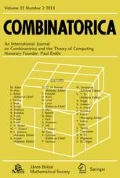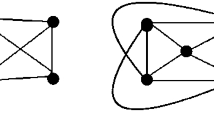Abstract
An (n, d, λ)-graph is a d regular graph on n vertices in which the absolute value of any nontrivial eigenvalue is at most λ. For any constant d ≥ 3, ϵ > 0 and all sufficiently large n we show that there is a deterministic poly(n) time algorithm that outputs an (n, d, λ)-graph (on exactly n vertices) with \(\lambda \le 2\sqrt {d - 1} + \). For any d=p + 2 with p ≡ 1 mod 4 prime and all sufficiently large n, we describe a strongly explicit construction of an (n, d, λ)-graph (on exactly n vertices) with \(\lambda \le \sqrt {2\left({d - 1} \right)} + \sqrt {d - 2} + o\left(1 \right)\left({< \left({1 + \sqrt 2} \right)\sqrt {d - 1} + o\left(1 \right)} \right)\), with the o(1) term tending to 0 as n tends to infinity. For every ϵ> 0, d> d0(ϵ) and n>n0(d, ϵ) we present a strongly explicit construction of an (m, d, λ)-graph with \(\lambda<\left({2 +} \right)\sqrt d \) and m = n + o(n). All constructions are obtained by starting with known Ramanujan or nearly Ramanujan graphs and modifying or packing them in an appropriate way. The spectral analysis relies on the delocalization of eigenvectors of regular graphs in cycle-free neighborhoods.
Similar content being viewed by others
References
N. Alon: Eigenvalues and expanders, Combinatorica 6 (1986), 83–96.
N. Alon and F. R. K. Chung: Explicit construction of linear sized tolerant networks, Discrete Math. 72 (1988), 15–19; (Proc. of the First Japan Conference on Graph Theory and Applications, Hakone, Japan, 1986.)
N. Alon, S. Ganguly and N. Srivastava: High-girth near-Ramanujan graphs with localized eigenvectors, Israel J. Math., to appear, arXiv:1908.03694, 2019.
R. C. Baker, G. Harman and J. Pintz: The difference between consecutive primes II., Proc. London Math. Soc. 83 (2001), 532–562.
A. Ben-Aroya and A. Ta-Shma: A combinatorial construction of almost Ramanujan graphs using the zig-zag product, SIAM Journal on Computing 40 (2011), 267–290.
C. Bordenave: A new proof of Friedman’s second eigenvalue theorem and its extension to random lifts, To appear in Annales scientifiques de lÉcole normale supérieure, arXiv:1502.04482v4, 2019.
S. M. Cioabă and M. Ram Murty: Expander graphs and gaps between primes, Forum Mathematicum 20 (2008), 745–756.
M. Cohen: Ramanujan graphs in polynomial time, in: Proceedings of the 57th Annual IEEE Symposium on Foundations of Computer Science, 276–281, 2016.
J. Friedman: Some geometric aspects of graphs and their eigenfunctions, Duke Mathematical Journal 69 (1993), 487–525.
J. Friedman: A proof of Alon’s second eigenvalue conjecture and related problems, Memoirs of the American Mathematical Society 195 (2008), viii+100.
D. R. Heath-Brown: Zero-free regions for Dirichlet L-functions, and the least prime in an arithmetic progression, Proc. London Math. Soc. (3) 64 (1992), 265–338.
S. Hoory, N. Linial and A. Wigderson: Expander graphs and their applications, Bull. Amer. Math. Soc. (N.S.) 43 (2006), 439–561.
N. Kahale: Eigenvalues and expansion of regular graphs, Journal of the ACM 42 (1995), 1091–1106.
M. Krivelevich and B. Sudakov: Pseudo-random graphs, in: More sets, graphs and numbers, 199–262, Bolyai Soc. Math. Stud., 15, Springer, Berlin, 2006.
A. Lubotzky: Discrete Groups, Expanding Graphs and Invariant Measures, Springer 2010
A. Lubotzky, R. Phillips and P. Sarnak: Ramanujan graphs, Combinatorica 8 (1988), 261–277.
G. A. Margulis: Explicit group-theoretical constructions of combinatorial schemes and their application to the design of expanders and superconcentrators, Problemy Peredachi Informatsii 24 (1988), 51–60 (in Russian). English translation in Problems of Information Transmission 24 (1988), 39–46.
S. Mohanty, R. O’Donnell and P. Paredes: Explicit near-Ramanujan graphs of every degree, arXiv:1909.06988v2.
M. Morgenstern: Existence and explicit constructions of q + 1 regular Ramanujan graphs for every prime power q, Journal of Combinatorial Theory, Series B 62 (1994), 44–62.
A. Marcus, D. Spielman and N. Srivastava: Interlacing families I: Bipartite Ramanujan graphs of all degrees, Annals of Mathematics, Second Series 182 (2015), 307–325.
J. Murtagh, O. Reingold, A. Sidford and S. Vadhan: Deterministic Approximation of Random Walks in Small Space, Proc. APPROX-RANDOM 42 (2019), 1–22.
A. Nilli: On the second eigenvalue of a graph, Discrete Mathematics 91 (1991), 207–210.
O. Reingold, S. Vadhan and A. Wigderson: Entropy waves, the zig-zag graph product, and new constant-degree expanders, Annals of Mathematics 155 (2002), 157–187.
M. Sha, E. Shparlinski and C. L. Stewart: On the distribution of multiplicatively dependenet vectors, arXiv:1903.09796.
R. Tijdeman: On the maximal distance between integers composed of small primes, Compos. Math. 28 (1974), 159–162.
Acknowledgment
I thank László Babai, Oded Goldreich, Ryan O’Donnell, Ori Parzanchevski, Peter Sarnak and Igor Shparlinski for illuminating discussions and references. I also thank the anonymous referees for helpful comments.
Author information
Authors and Affiliations
Corresponding author
Additional information
Research supported in part by NSF grant DMS-1855464, ISF grant 281/17, BSF grant 2018267 and the Simons Foundation.
Rights and permissions
About this article
Cite this article
Alon, N. Explicit Expanders of Every Degree and Size. Combinatorica 41, 447–463 (2021). https://doi.org/10.1007/s00493-020-4429-x
Received:
Revised:
Published:
Issue Date:
DOI: https://doi.org/10.1007/s00493-020-4429-x




